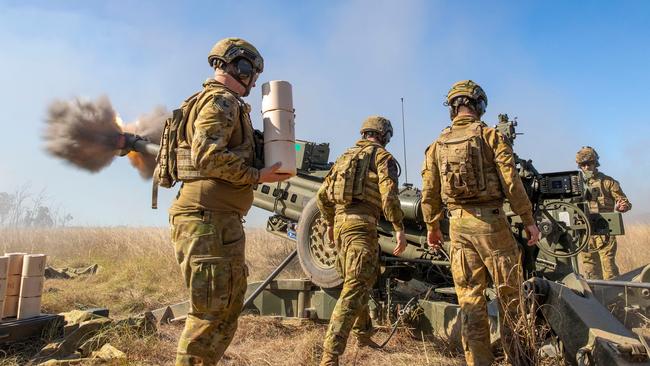Budget 2022: Defence spending static despite threats
Defence spending is forecast to remain under the 2 per cent of GDP benchmark this financial year despite worsening strategic circumstances.

Defence spending is forecast to remain under the 2 per cent of GDP benchmark this financial year despite worsening strategic circumstances and a $2.8bn cut to the department’s purchasing power due to soaring inflation.
The Albanese government’s first budget puts Defence spending at 1.96 per cent of GDP in 2022-23 – less than the 1.98 per cent posted by the Coalition the previous year – as it delays new acquisition programs until its submarines and defence strategic reviews are completed in March.
Defence spending is forecast to rise to 2.12 per cent in 2023-24 and remain at about that level for the next two years – far short of what will be required to deliver nuclear submarines and other capabilities to deter potential adversaries.
Inflation forecasts at 5.75 per cent through 2022-23, and 3.5 per cent the following year, will slash Defence’s effective budget by the equivalent of $2.8bn this financial year and $1.85bn the next.
In just a handful of new initiatives, the government will spend $6.9m to establish its promised Pacific Defence School, $32.2m to support defence manufacturing in Queensland, and $5.2m to develop renewable fuels for the military.
The budget also confirms an already announced $1.17bn budget allocation to recruit new ADF personnel.
Defence Minister Richard Marles said the budget “reinforces Defence’s readiness and capability to support our nation and promote stability and prosperity in our region”.
“As we face the most challenging geopolitical circumstances since the Second World War, the Albanese government is committed to properly managing every dollar of defence spending, and ensuring Defe
nce can deliver the capabilities ADF personnel need, when they need them,” he said.
Despite largely maintaining the budget settings of the former Coalition government, Mr Marles attacked his predecessor ministers for what he branded as a “decade of wasteful mismanagement”. The minister has accused the former government of presiding over $6.5bn in Defence budget blowouts and a cumulative 97 years in project delays.
But the Defence budget papers confirm progress will remain slow on key acquisitions, with just $943m set to be spent on the troubled $45bn Hunter-class frigate program in 2022-23, while a scant $250m will be spent this financial year on the navy’s $4bn guided weapon’s program.
The army’s $5.6bn Boxer combat reconnaissance vehicle program is on track to spend $686m this financial year, bringing expenditure to date to $2.5bn.
But there is no mention in the budget papers of the delayed $27bn infantry fighting vehicle program, which could face a cut when the defence strategic review is finalised.
There are also no new details on planned domestic missile production, the acquisition of US-made US High Mobility Artillery Rocket Systems, or measures to speed the procurement of the Australian Defence Force’s first armed drone.
The budget includes $220m this financial year for the in-development Ghost Bat drone, formerly known as the Loyal Wingman. The funds will be used to acquire an additional seven of the aircraft, which promises “fighter-like performance”. But, despite the essential role played by armed drones and loitering munitions in the Ukraine conflict, there is no word on when the aircraft will become operational.
Mr Marles has said the cost of the nation’s planned AUKUS submarines – the most ambitious project ever attempted in Australia – would begin to be reflected in the next federal budget, after Defence delivers its nuclear submarine task force report.
The final defence strategic review will be completed at the same time, identifying the urgent capabilities Australia will need to meet growing strategic threats.








To join the conversation, please log in. Don't have an account? Register
Join the conversation, you are commenting as Logout